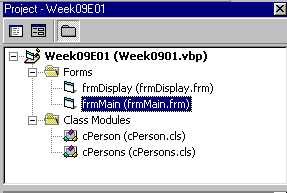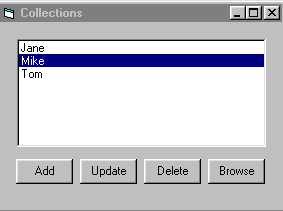Main uses the services of Display and the Collection Class module to perform this function. Very important is the separation of component responsibilities in this project.

| This example uses a Collection / Member Class pair to support
an Add, Display, Update, Delete, and Browse application maintaining information about
individuals. Main uses the services of Display and the Collection Class module to perform this function. Very important is the separation of component responsibilities in this project. |
|
 |
 |
The key to the Collection Class is the value in the ListBox.
The program will fail if you add a duplicate name
Description of the Classes
cPersons is the Collection Wrapper. All it needs to do is implement the Collection Wrapper functions.
cPerson is the Member Class. Its responsibility is only to implement the Get and Let Property Procedures for each of the Class Member Variables
Main Form
The Main Form must create the Collection Class object when it starts, and destroy it when it is finished.
Private Sub Form_Load()
Set m_Persons = New cPersons
End Sub
Private Sub Form_Unload(Cancel As Integer)
Set m_Persons = Nothing
End Sub
The Add, Display, Delete, Update, and Browse functions simply set an Action Code and Build the Display Screen. It must also maintain its own controls, and in this example involves only a ListBox that contains the Collection Class key value. There are unfortunatly two Build Sceen procedures. One of them when you know the Person you are going to display, and the other when you do not. If VB was more Polymorphic and supported Overloading, this code would be easier to implement
Private Sub BuildScreen()
Dim Person As cPerson
Set Person = m_Persons.Item(lstPerson.List(lstPerson.ListIndex))
TextToScreen Person
Set Person = Nothing
End Sub
Private Sub pBuildScreen(Person As cPerson)
TextToScreen Person
End Sub
Private Sub TextToScreen(Person As cPerson)
frmDisplay.txtName.Text = Person.Name
frmDisplay.txtAddress.Text = Person.Address
frmDisplay.txtCSZ.Text = Person.CSZ
frmDisplay.txtPhone.Text = Person.Phone
End Sub
The Main Form uses the services of the Collection Class and the Display Form
Display Form
The Display is really just a traffic controller. It responds to the request from Main, and sets the Screen Attributes as is required by the request.
| Public strMode As eMode Public blnCancel As Boolean The Request is made through strMode, which is of type eMode. strMode compares the request to the values allowed in the eMode definition. This makes the validation much cleaner. What are the values of the components of eMode? It does not matter! That's exactly why this type is used! |
Enum eMode eAdd eUpdate eDelete eBrowse eDisplay End Enum |
It's pretty easy to process the list of possible requests
Private Sub Form_Activate()
Select Case strMode
Case eDisplay
LockScreen True
cmdExit.Caption =
"&Return"
Case eAdd
ClearScreen
LockScreen False
txtName.SetFocus
cmdExit.Caption =
"&Add"
Case eUpdate
LockScreen False
txtName.Locked = True
txtAddress.SetFocus
cmdExit.Caption =
"&Update"
Case eDelete
LockScreen True
cmdExit.Caption =
"&Delete"
Case eBrowse
LockScreen True
cmdExit.Caption =
"&Next"
End Select
End Sub
Here are two procedures that use VB Collections to help manage the screen.
Private Sub ClearScreen()
Dim cControl As Control
For Each cControl In Me.Controls
If TypeOf cControl Is TextBox Then
cControl.Text =
""
End If
Next cControl
End Sub
Private Sub LockScreen(blnSet As Boolean)
Dim cControl As Control
For Each cControl In Me.Controls
If TypeOf cControl Is TextBox Then
cControl.Locked =
blnSet
End If
Next cControl
End Sub
Collection Class
Upon entry, the Class must build a Collection. Remember this collection class is a wrapper that implements the Collection Methods and Properties.
Private mPersons As Collection
Private Sub Class_Initialize()
Set mPersons = New Collection
End Sub
Private Sub Class_Terminate()
Set mPersons = Nothing
End Sub
All that is left to do is call on the Collection services to support the wrapper functions. Only Add needs to know about the details of the Member Class.
Public Sub Add(ByVal strName As String, _
ByVal strAddress As String, _
ByVal strCSZ As String, _
ByVal strPhone As String)
Dim Person As New cPerson
With Person
.Name = strName
.Address = strAddress
.CSZ = strCSZ
.Phone = strPhone
mPersons.Add Person, .Name
End With
End Sub
Public Sub Remove(ByVal strName As String)
mPersons.Remove strName
End Sub
Public Function Item(ByVal strName As String) As cPerson
Set Item = mPersons.Item(strName)
End Function
Public Property Get Count() As Long
Count = mPersons.Count
End Property
Each of these functions call the base Collection Class Methods.
Finally, there is the NewEnum Property Procedure required to support the Cpollection Class Enumeration. Note the Underscore in the code, and also make sure that you set the Procedure ID to -4 in the Procedure Attributes selection under the Tools menu item
Public Function NewEnum() As IUnknown
Set NewEnum = mPersons.[_NewEnum]
End Function
Member Class
The Member Class only provides Get and Let Property Procedues for each of its exposed variables.
Private m_strName As String
Private m_strAddress As String
Private m_strCSZ As String
Private m_strPhone As String
This is what makes this model easy to support for any Member Class. This is really just a
standalone class, and does not even know that it is being stored as part of a collection.